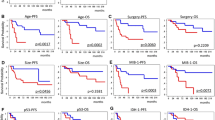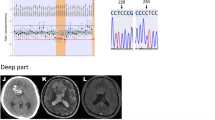Abstract
Not all Glioblastoma multiforme (GBM, grade IV WHO) manifest the same clinical course. Different prognostic classes may arise from different morphologic and genetic profiles. The observation of oligodendroglial foci within GBM samples and their correlation with genetic alterations may predict a better prognosis. 450 patients affected by histologically proven supratentorial cerebral GBM were treated at our institutions from January 2000 to December 2006: all patients received at least subtotal surgical removal, followed by the same standard radio-chemotherapy adjuvant treatment. In a subgroup of 36 patients (8.0%) an oligodendroglial component was observed. Molecular assessment of these cases was performed and LOH for 1p, 19q and 10q, EGFR amplification and TP53 gene expression was determined. Median age of this subgroup was 52.1 years (range: 29–78 years) vs 62.4 years in the entire GBM population. Chromosome analysis resulted as follows: LOH 1p and/or 19q in 27 cases (75.0%), LOH of 10q in 21 cases (58.1%), EGFR amplification in 14 cases (39%) and TP53 mutation in eight patients (22.2%). OS was of 20.9 months while it was 13.6 months in the entire GBM population. Progression free survival (PFS) was 10.3 months and 7.6 months the entire group. Two-year survival was of 55%. The presence of an oligodendroglial component in GBM appears to be an important prognostic factor to which better prognosis can be related. LOH 1p and 19q was significantly associated with GBM with oligodendroglial component.


Similar content being viewed by others
References
Louis DN, Ohgaki H, Wiestler OD, Cavenee WK (eds) (2007) World Health Organization classification of tumours of the central nervous system. IARC Press, Lyon, pp 33–49
Homma T, Fukushima T, Vaccarella S, Yonekawa Y, Di Patre PL, Franceschi S, Ohgaki H (2006) Correlation among pathology, genotype and patient outcome in glioblastoma. J Neuropathol Exp Neurol 65(9):846–854. doi:10.1097/01.jnen.0000235118.75182.94
Kraus JA, Glesmann N, Beck M et al (2000) Molecular analysis of the PTEN, TP53 and CDKN2A tumor suppressor genes in long- term survivors of glioblastoma multiforme. J Neurooncol 48:89–94. doi:10.1023/A:1006402614838
Houillier C, Lejeune J, Benouaich-Amiel A et al (2006) Prognostic impact of molecular markers in a series of 220 primary glioblastomas. Cancer 106:2218–2223. doi:10.1002/cncr.21819
Nakamura M, Yang F, Fujisawa H, Yonekawa Y, Kleihues P, Ohgaki H (2000) Loss of heterozygosity on chromosome 19 in secondary glioblastomas. J Neuropathol Exp Neurol 59:539–543
Okamoto Y, Di Patre PL, Burkhard C et al (2004) Population- based study on incidence, survival rates, and genetic alterations of low-grade astrocytomas and oligodendrogliomas. Acta Neuropathol 108:49–56. doi:10.1007/s00401-004-0861-z
Hegi ME, Diserens AC, Gorlia T, Hamou MF, de Tribolet N, Weller M, Kros JM, Hainfellner JA, Mason W, Mariani L, Bromberg JE, Hau P et al (2005) MGMT gene silencing and benefit from temozolomide in glioblastoma. N Engl J Med 352:997–1003. doi:10.1056/NEJMoa043331
Kraus JA, Lamszus K, Glesmann N, Beck M, Wolter M, Sabel M, Krex D, Klockgether T, Reifenberger G, Schlegel U (2001) Molecular genetic alterations in glioblastomas with oligodendroglial component. Acta Neuropathol 101:311–320
Hilton DA, Penney M, Pobereskin L, Sanders H, Love S (2004) Histological indications of prognosis in glioblastomas: retinoblastoma protein expression and oligodendroglial differentiation indicate improved survival. Histopathology 44:555–560. doi:10.1111/j.1365-2559.2004.01887.x
Decaestecker C, Camby I, Gordower L et al (1998) Characterization of astroglial versus oligodendroglial phenotypes in glioblastomas by means of quantitative morphonuclear variables generated by computer-assisted microscopy. J Neuropathol Exp Neurol 57:791–802. doi:10.1097/00005072-199808000-00008
He J, Mokhtari K, Sanson M, Marie Y, Kujas M, Huguet S, Leuraud P, Capelle L, Delattre JY, Poirier J, Hoang-Xuan K (2001) Glioblastomas with oligodendroglial component: a pathological and molecular study. J Neuropathol Exp Neurol 60:863–871
Ghimenti C, Fiano V, Chiadò-Piat L, Chiò A, Cavalla P, Schiffer D (2003) Deregulation of the p14ARF/Mdm2/p53 pathway and G1/S transition in two glioblastoma sets. J Neurooncol 61:95–102. doi:10.1023/A:1022127302008
Dehais C, Laigle-Donadey F, Marie Y, Kujas M, Lejeune J, Benouaich-Amiel A, Pedretti M, Polivka M, Hoang-Xuan K, Thillet J, Delattre JY, Sanson M (2006) Prognostic stratification of patients with anaplastic gliomas according to genetic profile. Cancer 107:1891–1897. doi:10.1002/cncr.22211
Ueki K, Nishikawa R, Nakazato Y, Hirose T, Hirato J, Funada N, Fujimaki T, Hojo S, Kubo O, Ide T, Usui M, Ochiai C et al (2002) Correlation of histology and molecular genetic analysis of 1p, 19q, 10q, TP53, EGFR, CDK4 and CDKN2A in 91 astrocytic and oligodendroglial tumors. Clin Cancer Res 8:196–201
Reifenberger J, Ring GU, Gies U, Cobbers L, Oberstrass J, An HX, Niederacher D, Wechsler W, Reifenberger G (1996) Analysis of p53 mutation and epidemial growth factor receptor amplification in recurrent gliomas with malignant progression. J Neuropathol Exp Neurol 55:822–831. doi:10.1097/00005072-199607000-00007
von Deimling A, Nagel J, Bender B et al (1994) Deletion mapping of chromosome 19 in human gliomas. Int J Cancer 57:676–680. doi:10.1002/ijc.2910570511
Nutt CL, Mani DR, Betensky RA, Tamayo P, Cairncross JG, Ladd C, Pohl U, Hartmann C, McLaughlin ME, Batchelor TT, Black PM, von Deimling A, Pomeroy SL, Golub TR, Louis DN (2003) Gene expression-based classification of malignant gliomas correlates with better survival than histological classification. Cancer Res 63:1602–1607
Idbaih A, Marie Y, Pierron G et al (2005) Two types of chromosome 1p losses with opposite significance in gliomas. Ann Neurol 58:483–487. doi:10.1002/ana.20607
Kraus JA, Wegendorfer M, Schmidt MC, von Deimling A, Berweiler U, Roggendorf W, Diete S, Dietzmann K, Müller B, Heuser K, Reifenberger G, Schlegel U (2000) Long-term survival of glioblastoma multiforme: importance of histopathological reevaluation. J Neurol 247:455–460. doi:10.1007/s004150070175
Caincross JG, Ueki K, Zlatescu MC et al (1998) Specific genetic predictors of chemotherapeutic response and survival in patients with anaplastic oligodendrogliomas. J Natl Cancer Inst 90:1473–1479. doi:10.1093/jnci/90.19.1473
Ino Y, Zlatescu M, Sasaki H et al (2000) Long survival and therapeutic responses in patients with histologically disparate high grade gliomas demonstrating chromosome 1p loss. J Neurosurg 92:983–990
Vordermark D, Ruprecht K, Rieckmann P, Roggendorf W, Vince GH, Warmuth-Metz M, Koelbl O, Flentje M (2006) Glioblastoma multiforme with oligodendroglial component (GMBO): favorable outcome after post-operative radiotherapy and chemotherapy with nimustine (ACNU) and tenipside (VM 26). BMC Cancer 6:247. doi:10.1186/1471-2407-6-247
Author information
Authors and Affiliations
Corresponding author
Rights and permissions
About this article
Cite this article
Salvati, M., Formichella, A.I., D’Elia, A. et al. Cerebral glioblastoma with oligodendrogliomal component: analysis of 36 cases. J Neurooncol 94, 129–134 (2009). https://doi.org/10.1007/s11060-009-9815-6
Received:
Accepted:
Published:
Issue Date:
DOI: https://doi.org/10.1007/s11060-009-9815-6




